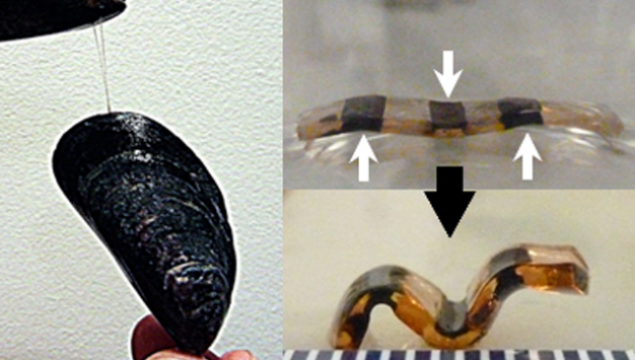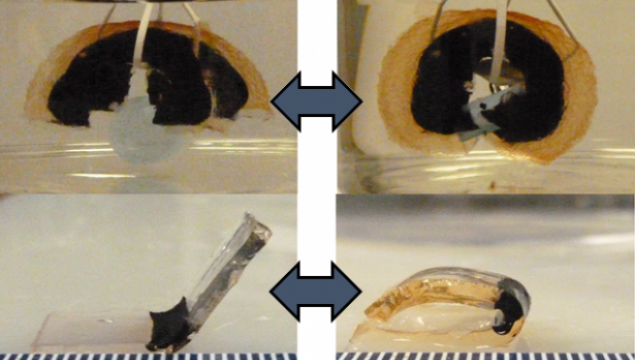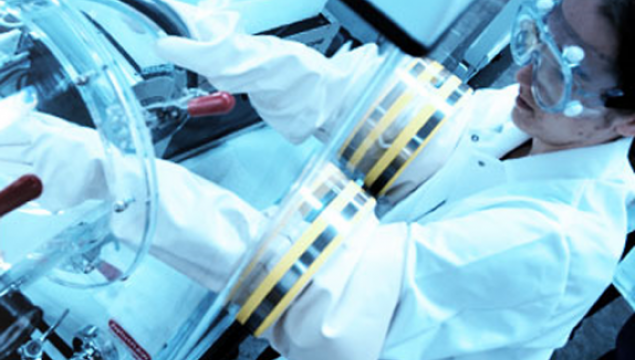Mussel Chemistry Inspired Hydrogel Actuator
Why This Project Is Important
Man-made machines are composed mainly of hard materials (e.g., metal rods, mechanical joints, and electric motors), which can be disadvantageous in applications that require handling materials and structures that are soft, fragile, or complex in shape. On the other hand, soft machineries are found in animals and plants that provide locomotion and autonomous motion (e.g., muscle tissues), and the ability to adapt to environmental stimuli (e.g., rotation of plant toward the sun) that are critical to the survival and function of these organisms. Development of these soft machineries are critical in further advancing medical devices that interface with biological systems (e.g., microsurgery), prostheses with improved implant-tissue interface compatibility (e.g., neuroprosthesis), and biomaterials for regenerating function of diseased tissues.
Project Description
We seek to develop hydrogel based actuator that can potentially function as soft robotic components. Hydrogels are soft networks of polymers with high water content, like jello. Because of their soft, gentle texture, they have the potential to interact safely with living tissues and have applications in a number of biomedical applications, including tissue engineering and adhesives for regenerating functional tissues. To make our movable hydrogel, we borrowed chemistry from adhesive proteins that mussels use to anchor themselves to surfaces under water. These biomimetic hydrogels can be programed to transform from a flat film into various 3-dimentional shapes in response to changes in the environment (i.e., pH). You can even make it into an X-shaped claw, so that it may be able to pick up a small object. We aim to better understand these novel hydrogel actuators. What can we do to control the speed at which these hydrogels move? How reproducible are their movements? Are these materials safe when placed in contact with living cells? These are important questions that we need to answer in order to develop soft robotic components using mussel-inspired chemistry.
Meet the Researcher

Bruce Lee
The Lee group research is focused on applying biologically-inspired molecular designs with chemistry, polymer engineering and materials science principles in developing advanced and functional materials for various biomedical applications. Current projects include applying biomimetic structural designs to create tough hydrogels that can potentially function as tissue adhesives or extracellular matrices for tissue repair and regeneration, and hydrogel actuators and smart adhesives.
Prior to joining Michigan Tech, Dr. Lee helped found a start-up company, Nerites Corporation, which aimed at commercializing biomimetic bioadhesive and antifouling technologies. Nerites Corporation was acquired by Kensey Nash Corporation (part of Royal DSM) in 2011.
days left
funded
last
What Your Donation Can Help Us Do:
- Purchase supplies
- Provide salary for graduate research assistants
- Generate preliminary data to obtain federal funding
$5+ (5/100)
Email with tax deduction info
$50+ (5/45)
Email with tax deduction info, name listed among donors in annual report.
$100+ (3/20)
Email with tax deduction info, name listed among donors in annual report, and a Michigan Tech key chain.
$250+ (0/5)
Email with tax deduction info, name listed among donors in annual report, and a Michigan Tech polo shirt
$1,000+ (0/4)
Email with tax deduction info, name listed among donors in annual report, and a Michigan Tech sweat shirt
Recent Donors
Some donors may be hidden.







 Gifts to projects listed on SUPERIORIDEAS.ORG are received and processed by Michigan Tech Fund. Michigan Tech Fund is a tax-exempt organization under Section 501(c)(3) of the Internal Revenue Code acting on behalf of Michigan Technological University. It is the policy of Michigan Tech Fund that a portion of the gifts and/or income therefrom may be used to defray the costs of raising and administering the funds.
Gifts to projects listed on SUPERIORIDEAS.ORG are received and processed by Michigan Tech Fund. Michigan Tech Fund is a tax-exempt organization under Section 501(c)(3) of the Internal Revenue Code acting on behalf of Michigan Technological University. It is the policy of Michigan Tech Fund that a portion of the gifts and/or income therefrom may be used to defray the costs of raising and administering the funds.